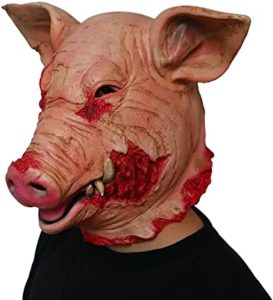 I set out this week to write a column about how a silly rubber mask was used for something other than a Halloween costume.
I set out this week to write a column about how a silly rubber mask was used for something other than a Halloween costume.
A few weeks ago, my friend Joye Andrews posted on Facebook that she was teaching William Golding’s “Lord of the Flies” to her Humanities class at Cookeville High School. She was searching for a large conch shell, which plays an integral part in the novel, to use for a prop. Another teacher replied with a picture of a bloody pig head mask she’d seen on amazon. “For less than twenty bucks, you can buy something way better than a conch shell,” she said.
Torn between which prop would make the dystopian novel more memorable for her students, Joye splurged and bought both a shell and the mask. For good measure, she added a package of rubber flies. I asked Joye if I could feature her in this column. When she said yes, I checked out a copy of “Lord of the Flies” from the library.
The only time I’d read it was more than 50 years ago, as an assignment in tenth grade. Though I couldn’t recollect all the details, I remembered the basics. A group of British boys is marooned on a deserted island after a plane crash. No adults survived. At first, the boys think a grand adventure awaits. A jungle to play in. A lagoon to swim in. Fresh fruit hanging within arm’s reach. No uniforms. No soap or toothbrushes. Best of all, no rules.
But things quickly deteriorate. There’s bad weather. Scary noises. Hunger. Power struggles. A not-so-slow descent into savagery, which is the theme of the novel.
It’s a short book, but not an easy one. Published in 1954, it was one of the first dystopian novels for young adult readers. These days, there are countless books in that genre. Far more than I care to keep up with. But I can’t imagine any of them being more disturbing or unforgettable than “Lord of the Flies.”
The theme of Joye’s Humanities class during fall quarter was “belonging.” She knew “Lord of the Flies” would be a perfect springboard for discussion of that topic. “This isn’t a class where we talk about literary devices, though there are many in this novel,” she told me. “What we do when we read a book like this is discuss its themes and how the book affected us.”
Pigs are of major significance in the novel. Wild hogs are the only source of protein on the island (fresh fruit can’t satisfy nutritional needs for long), so one group of boys becomes hunters. Another group is charged with keeping a signal fire burning atop a mountain in hopes that a passing ship will see it and come to the rescue. A fierce rivalry soon develops between twelve-year-old Ralph, the democratically elected leader who insists that the fire is top priority, and twelve-year-old Jack, who believes that meat is far more important.
In one of the novel’s most memorable scenes, the hunters kill a pig, cut off its head and mount it on a pointed stick. It’s soon covered with flies. The symbolism—that evil lives inside every boy on the island—is obvious and horrible.
Space limitations prevent me from saying much more about “Lord of the Flies” except that it includes a beautiful conch shell that allows the boy who’s holding it to speak at assembly, a terrifying beast, a pair of broken eyeglasses and some violent human deaths. Joye told me that, one day during silent reading time, one of her students quietly closed his book, let out a big sigh and shook his head. “This is really hard to read,” he said.
He’s right. Which is why this column turned out to be about more than a silly rubber mask.
(October 30, 2021)